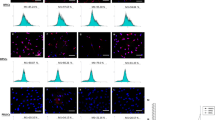Abstract
Dental stem cells represent a good treatment option in regenerative dentistry. Regeneration of large bone defects can be achieved by a cell-based therapy consisting of osteogenic progenitor cells, such as dental follicle precursor cells (DFCs), in combination with bone substitute material used as a scaffold. A previous trial had shown that β-tricalcium phosphate (TCP) improves the osteogenic differentiation of DFCs. In the present trial, we investigated the attachment, survival, and proliferation of DFCs on TCP in more detail. A high initial cell number was required for the adhesion, attachment, and sufficient proliferation of DFCs on a TCP scaffold. The TCP scaffold released fine soluble particles enriched in TCP eluates that induced cell death and showed typical characteristics of programmed cell death (apoptosis) in DFCs. During cultivation on the TCP scaffold, DFCs showed a highly upregulated expression of antiapoptotic genes but a downregulated expression of proapoptotic markers. In conclusion, TCP supports osteogenic differentiation in DFCs but also induces programmed cell death. Our data suggest that surviving DFCs avoid programmed cell death by inducing antiapoptotic genes.





Similar content being viewed by others
References
Hollister SJ (2005) Porous scaffold design for tissue engineering. Nat Mater 4(7):518–524
Polini A, Pisignano D, Parodi M, Quarto R, Scaglione S (2011) Osteoinduction of human mesenchymal stem cells by bioactive composite scaffolds without supplemental osteogenic growth factors. PLoS One 6(10):e26211
Kamitakahara M, Ohtsuki C, Miyazaki T (2008) Behavior of ceramic biomaterials derived from tricalcium phosphate in physiological condition. J Biomater Appl 23(3):197–212
Wang F-M, Qiu K, Hu T, Wan C-X, Zhou X-D, Gutmann JL (2006) Biodegradable porous calcium polyphosphate scaffolds for the three-dimensional culture of dental pulp cells. Int Endod J 39(6):477–483
LeGeros RZ (2008) Calcium phosphate–based osteoinductive materials. Chem Rev 108(11):4742–4753
Sánchez-Salcedo S, Balas F, Izquierdo-Barba I, Vallet-Regí M (2009) In vitro structural changes in porous HA/beta-TCP scaffolds in simulated body fluid. Acta Biomater 5(7):2738–2751
Rojbani H, Nyan M, Ohya K, Kasugai S (2011) Evaluation of the osteoconductivity of α-tricalcium phosphate, β-tricalcium phosphate, and hydroxyapatite combined with or without simvastatin in rat calvarial defect. J Biomed Mater Res A 98(4):488–498
Miyamoto S, Shinmyouzu K, Miyamoto I, Takeshita K, Terada T, Takahashi T (2012) Histomorphometric and immunohistochemical analysis of human maxillary sinus-floor augmentation using porous β-tricalcium phosphate for dental implant treatment. Clin Oral Implants Res. doi: 10.1111/j.1600-0501.2011.02396.x
Luan X, Ito Y, Dangaria S, Diekwisch TG (2006) Dental follicle progenitor cell heterogeneity in the developing mouse periodontium. Stem Cells Dev 15(4):595–608
Kemoun P, Narayanan AS, Brunel G et al (2007) Human dental follicle cells acquire cementoblast features under stimulation by BMP-2/-7 and enamel matrix derivatives (EMD) in vitro. Cell Tissue Res 329(2):283–294
Morsczeck C, Gotz W, Schierholz J, Zeilhofer F, Kuhn U, Mohl C, Sippel C, Hoffmann KH (2005) Isolation of precursor cells (PCs) from human dental follicle of wisdom teeth. Matrix Biol 24(2):155–165
Handa K, Saito M, Yamauchi M, Kiyono T, Sato S, Teranaka T, Sampath Narayanan A (2002) Cementum matrix formation in vivo by cultured dental follicle cells. Bone 31(5):606–611
Viale-Bouroncle S, Bey B, Reichert TE, Schmalz G, Morsczeck C (2011) β-Tricalcium-phosphate stimulates the differentiation of dental follicle cells. J Mater Sci Mater Med 22(7):1719–1724
Horch H-H, Sader R, Pautke C, Neff A, Deppe H, Kolk A (2006) Synthetic, pure-phase beta-tricalcium phosphate ceramic granules (Cerasorb) for bone regeneration in the reconstructive surgery of the jaws. Int J Oral Maxillofac Surg 35(8):708–713
Lange T, Schilling AF, Peters F, Mujas J, Wicklein D, Amling M (2011) Size dependent induction of proinflammatory cytokines and cytotoxicity of particulate beta-tricalcium phosphate in vitro. Biomaterials 32(17):4067–4075
Lin K, Yuan W, Wang L, Lu J, Chen L, Wang Z, Chang J (2011) Evaluation of host inflammatory responses of β-tricalciumphosphate bioceramics caused by calcium pyrophosphate impurity using a subcutaneous model. J Biomed Mater Res B 99(2):350–358
Lynch MP, Capparelli C, Stein JL, Stein GS, Lian JB (1998) Apoptosis during bone-like tissue development in vitro. J Cell Biochem 68(1):31–49
Manolagas SC (2000) Birth and death of bone cells: basic regulatory mechanisms and implications for the pathogenesis and treatment of osteoporosis. Endocr Rev 21(2):115–137
Morsczeck C, Völlner F, Saugspier M, Brandl C, Reichert TE, Driemel O, Schmalz G (2010) Comparison of human dental follicle cells (DFCs) and stem cells from human exfoliated deciduous teeth (SHED) after neural differentiation in vitro. Clin Oral Investig 14(4):433–440
Lange T, Schilling AF, Peters F, Haag F, Morlock MM, Rueger JM, Amling M (2009) Proinflammatory and osteoclastogenic effects of beta-tricalciumphosphate and hydroxyapatite particles on human mononuclear cells in vitro. Biomaterials 30(29):5312–5318
Alcaide M, Serrano M-C, Pagani R, Sánchez-Salcedo S, Vallet-Regí M, Portolés M-T (2009) Biocompatibility markers for the study of interactions between osteoblasts and composite biomaterials. Biomaterials 30(1):45–51
Larsen BD, Rampalli S, Burns LE, Brunette S, Dilworth FJ, Megeney LA (2010) Caspase 3/caspase-activated DNase promote cell differentiation by inducing DNA strand breaks. Proc Natl Acad Sci USA 107(9):4230–4235
Acknowledgments
We thank Ms. Carola Bolay, Ms. Zahra Tayarani, and Mr. Marcel Hoh for their technical support.
Author information
Authors and Affiliations
Corresponding author
Additional information
The authors have stated that they have no conflict of interest.
Rights and permissions
About this article
Cite this article
Viale-Bouroncle, S., Buergers, R., Morsczeck, C. et al. β-Tricalcium Phosphate Induces Apoptosis on Dental Follicle Cells. Calcif Tissue Int 92, 412–417 (2013). https://doi.org/10.1007/s00223-012-9694-2
Received:
Accepted:
Published:
Issue Date:
DOI: https://doi.org/10.1007/s00223-012-9694-2




